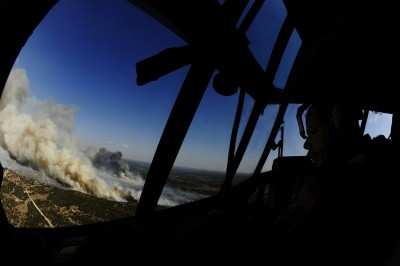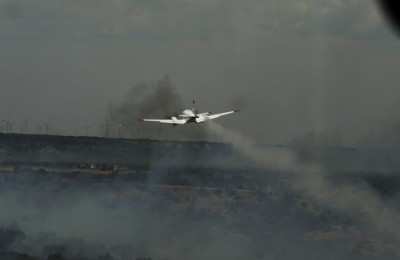Sat, Apr 30, 2011
Colorado Air Force Units Assisting In Fighting Texas
Wildfires
Two Modular Airborne Firefighting System-equipped C-130 Hercules
aircraft from Air Force Reserve Command's 302nd Airlift Wing at
Peterson Air Force Base, CO, deployed to Texas April 26 to provide
additional aerial support to contain wildland fires that have
plagued Texas for several weeks. The C-130s flew their first aerial
retardant drop sorties shortly after arriving to join the 302nd Air
Expeditionary Group, which is deployed to Dyess AFB in Abilene,
Texas, to support the National Interagency Fire Center.

USAF Photo
The arrival of the 302nd AW MAFFS aircraft also marked the
re-deployment of aircraft from the North Carolina Air National
Guard's 145th AW and the Wyoming ANG's153rd AW to their respective
home stations. "The 145th and 153rd have provided critical and
timely support to the region and to the MAFFS operation as a
whole," said Col. Jay Pittman, the 302nd AEG commander. "The
arrival of the aircraft from Peterson allows for a seamless
transition for us to continue providing valuable firefighting
capabilities to the citizens of Texas as long as our support is
needed."
Since April 17, aircraft assigned to the 302nd AEG have flown 44
missions, dropping 132,000 gallons of fire retardant in an attempt
to contain wildfires. The MAFFS is a self-contained aerial
firefighting system, which can discharge 3,000 gallons of water or
fire retardant in less than five seconds, covering an area
one-quarter of a mile long by 60 feet wide. Once the load is
discharged, a MAFFS unit can be refilled in less than 12
minutes.

USAF Photo
The MAFFSs are owned by the U.S. Forest Service, a cooperative
partner with the National Interagency Fire Center based in Boise,
Idaho. NIFC is the lead federal agency for these firefighting
efforts, and the Department of Defense is flying in support of the
NIFC mission.
AFNORTH is the air component for U.S. Northern Command and when
tasked, provides support to local, state, tribal, regional and
federal emergency service agencies.
More News
Airport Marking Aids Markings used on runway and taxiway surfaces to identify a specific runway, a runway threshold, a centerline, a hold line, etc. A runway should be marked in ac>[...]
"It is extremely difficult, if not impossible, for manned aircraft to see a drone while conducting crop-enhancing and other aerial applications at low altitudes and high speeds. We>[...]
Aero Linx: The Skyhawk Association The Skyhawk Association is a non-profit organization founded by former Skyhawk Pilots which is open to anyone with an affinity for the A-4 Skyhaw>[...]
“The T-54A benefits from an active Beechcraft King Air assembly line in Wichita, Kansas, where all required METS avionics and interior modifications are installed on the line>[...]
Aero Linx: Aerostar Owners Association The Association offers the Aerostar Owner a unique opportunity to tap an invaluable source of information concerning the care and feeding of >[...]
 ANN's Daily Aero-Term (04.28.24): Airport Marking Aids
ANN's Daily Aero-Term (04.28.24): Airport Marking Aids Aero-News: Quote of the Day (04.28.24)
Aero-News: Quote of the Day (04.28.24) ANN's Daily Aero-Linx (04.28.24)
ANN's Daily Aero-Linx (04.28.24) Aero-News: Quote of the Day (04.29.24)
Aero-News: Quote of the Day (04.29.24) ANN's Daily Aero-Linx (04.29.24)
ANN's Daily Aero-Linx (04.29.24)




